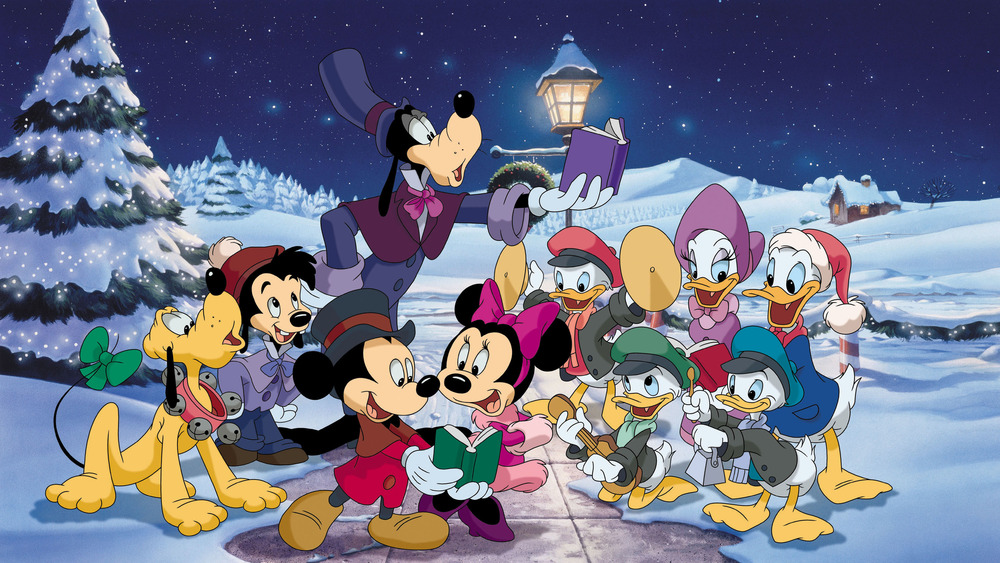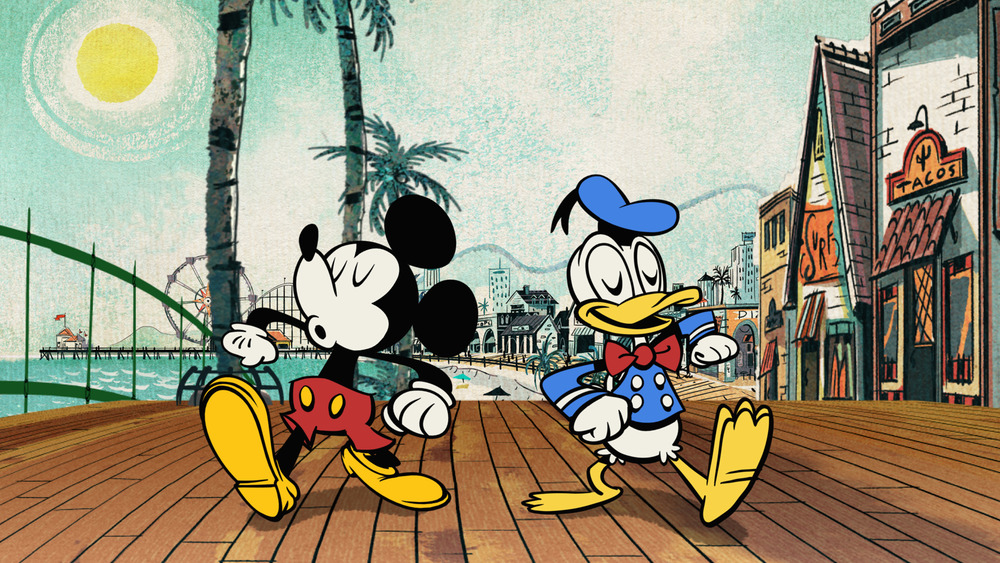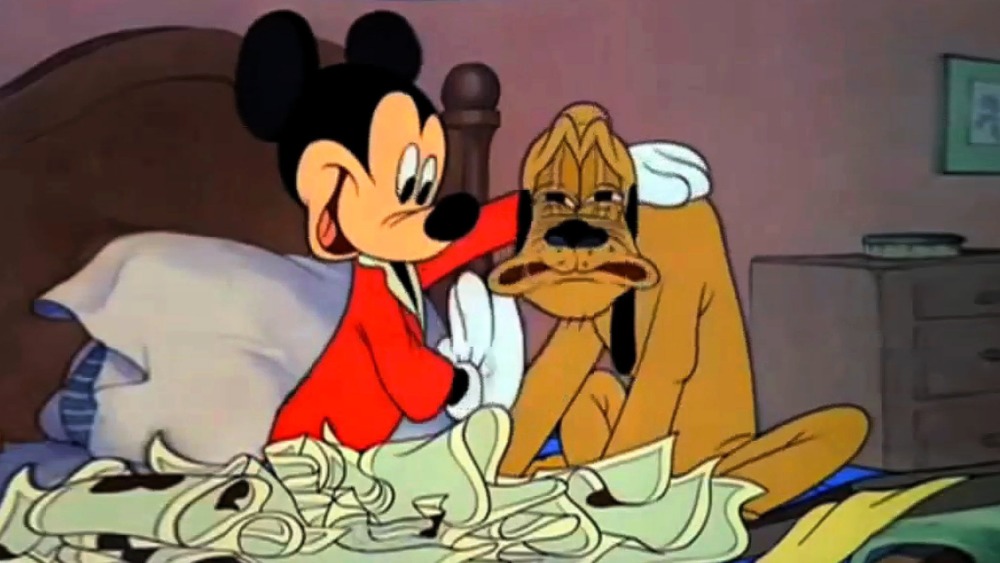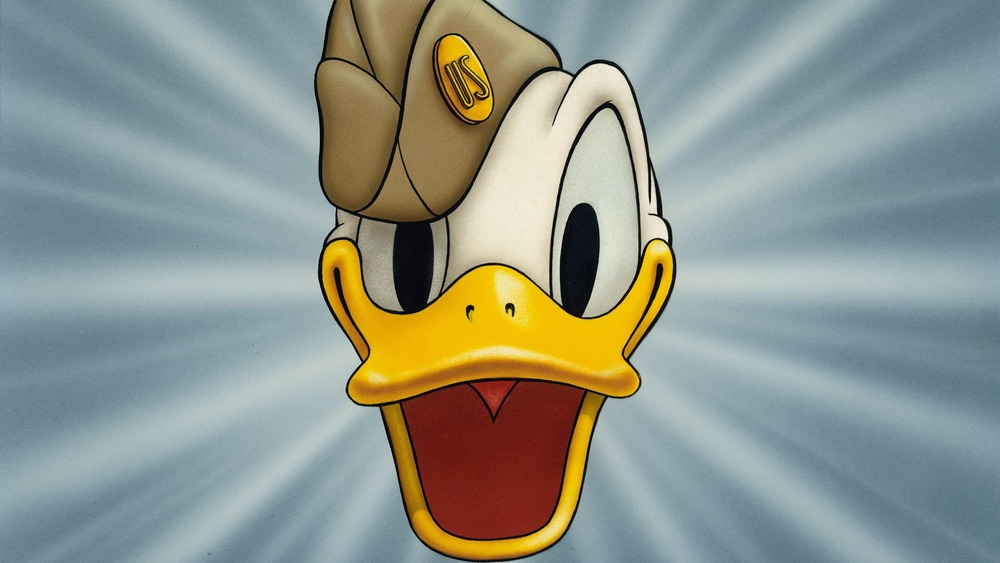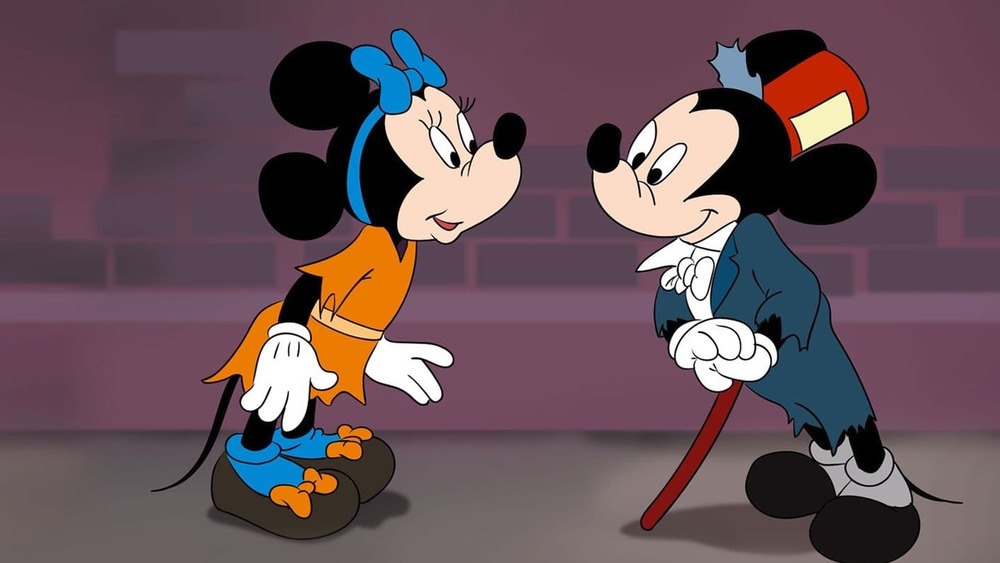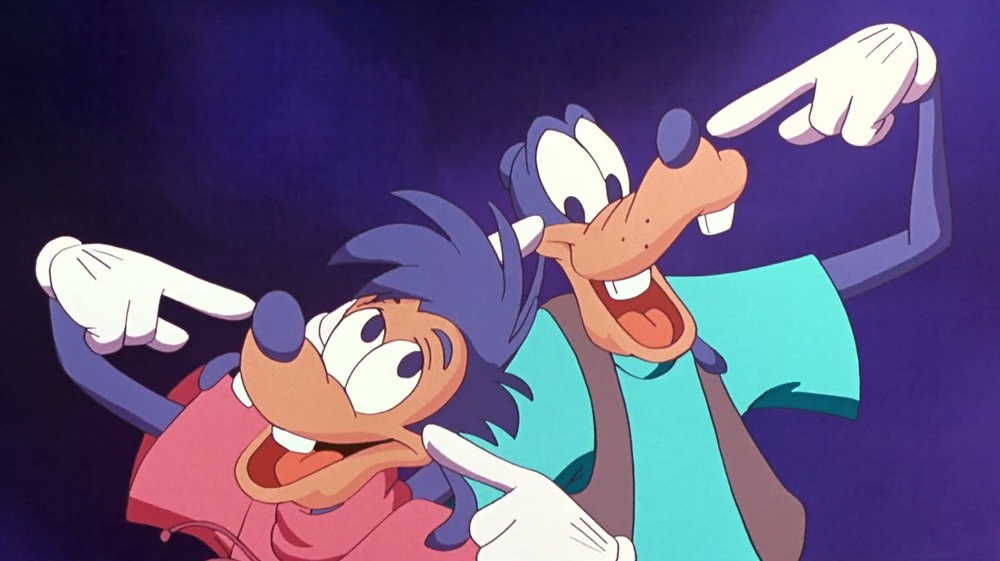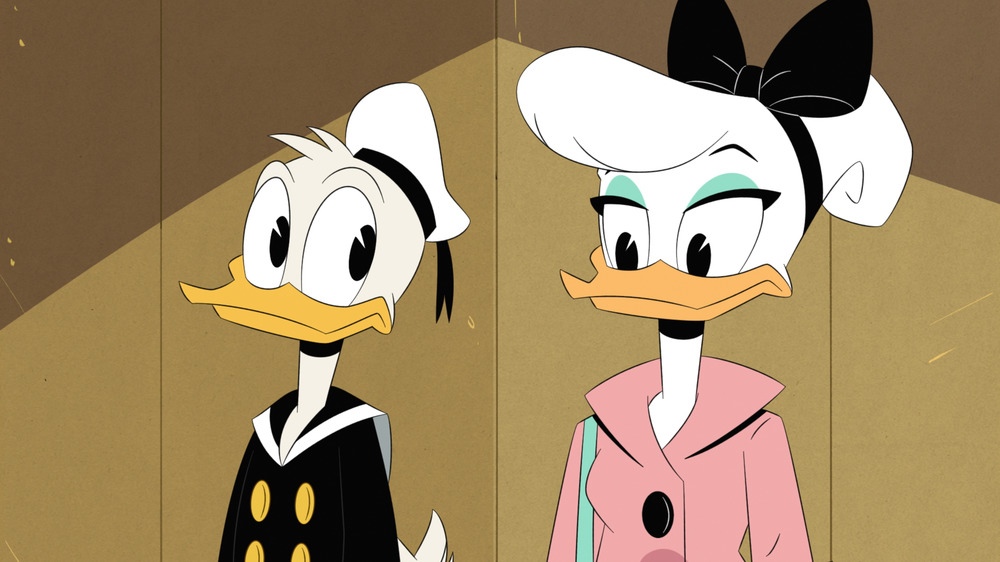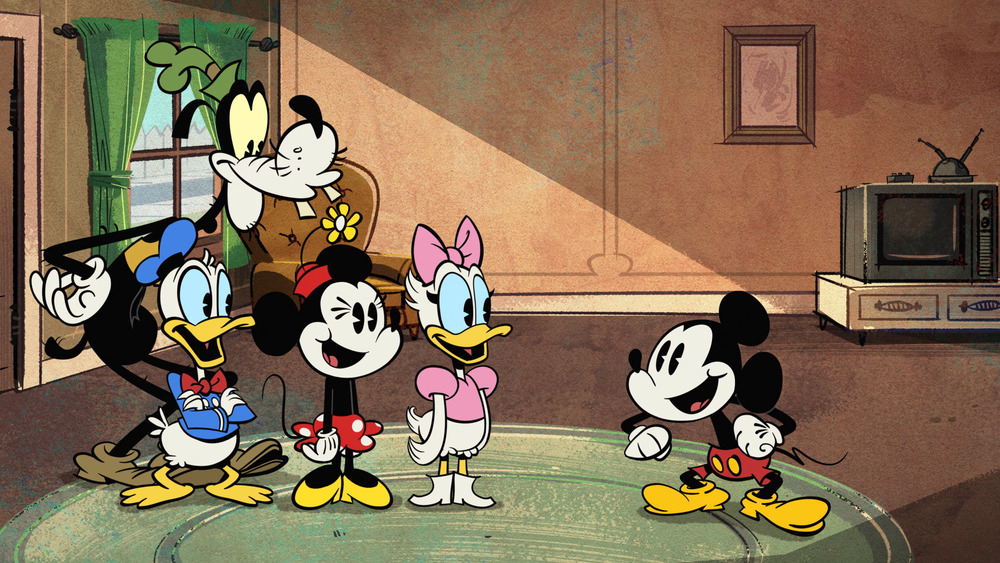The Real Reason You Rarely See Disney's Sensational Six In Movies
Mickey. Minnie. Pluto. Donald. Daisy. Goofy. Collectively known as "the Sensational Six," these are some of the most beloved cartoon characters in history. In fact, you could say that they are history, being among the earliest creations of animation pioneer Walt Disney. Ever since Mickey Mouse's debut in the first cartoon to feature synchronized sound, Steamboat Willie (1928), the Sensational Six have been breaking ground and finding new audiences by appearing in short films, television series, comic books, video games and theme park attractions, and by having their images branded on a dizzying array of merchandise, from orange juice to high end jewelry. Their nearly ubiquitous presence makes one omission on their collective resume all the more glaring: the Sensational Six rarely appear in feature-length movies.
There are some exceptions. A Goofy Movie (1995) has garnered late praise over the years, and the direct-to-video feature Mickey's Once Upon a Christmas (1999) has joined many families' holiday viewing list. 2004 saw the release of a direct-to-video adaptation of The Three Musketeers starring the trio of Mickey Mouse, Donald Duck and Goofy. In over 90 years, however, their appearances in feature films have largely been limited to cameos, such as Mickey's brief but memorable scene alongside Bugs Bunny in Who Framed Roger Rabbit? (1988), or roles in anthology films, like Mickey playing "the Sorcerer's Apprentice" in Fantasia (1940). The Walt Disney Company excels at exploiting their deep catalog, so why haven't we seen more movies from six of their most famous characters?
Keep 'em in their shorts!
Mickey and friends are actually older than feature animation. Feature length cartoons were virtually unheard of before 1937, when Disney stunned the world with Snow White and the Seven Dwarfs, which was a box office smash and earned an honorary Academy Award for its revolutionary achievements.
The Sensational Six are products of the earliest days of sound film, when an afternoon at the cinema included a program of shorts and cartoons before the feature. Running times of under eight minutes were standard for cartoons of that era, so "shorts" are their native form. Prior to Snow White, critics assumed that cartoons lacked the depth or "relatability" to keep an audience interested for a whole movie. To some extent, Walt Disney may have feared that too, choosing to adapt a popular fairy tale for his first feature, rather than expand the world of his original superstars. With the era of TikTok and YouTube, short content is more popular than ever, which may explain the appearance in 2013 of Disney Channel's Mickey Mouse, a collection of three-to-seven minute shorts.
Role model Mickey
From his earliest appearances, Mickey Mouse was enormously popular with kids as a scrappy but lovable underdog in the mold of the era's popular comedians, Buster Keaton and Charlie Chaplin. As Walt began to see the character as a role model for children, he shifted some of Mickey's negative traits — like his mischievousness and anger issues — to a new character, Donald Duck. Similarly, his... well, goofier tendencies were given to the pratfall-prone Goofy, which reduced Mickey to playing the wholesome straight man to his funnier friends. Mickey Mouse was also closely associated with Walt Disney, who not only co-created Mickey with his animation partner, Ub Iwerks, but also provided the character's voice. Protecting both of their images, Disney began to utilize Mickey Mouse less as a character and more as a company mascot. Rather than risk the image, Mickey and his faithful sidekicks were largely sidelined from features.
The Nazis ruin everything
In 1940, Disney followed up Snow White with an impressive one-two punch of classic animation: Pinocchio and Fantasia, an anthology film in which Mickey played his most iconic role, the Sorcerer's Apprentice. Unfortunately, World War II was raging in Europe, drastically limiting their releases. Walt Disney was able to keep his studio running by making training and propaganda films for the U.S. Army, but production of animated features ground to a halt.
By the time the war ended, Disney was hungry for a hit and simply telling a feature story with characters from his shorts — even beloved ones like the Sensational Six — was just not Walt's style (when asked why he didn't produce a sequel to his Academy Award-winning short, "The Three Little Pigs," Walt replied, "You can't top pigs with pigs"). Walt's first post-war effort was the problematic Song of the South, which did little to help his bottom line. By necessity, he would move into cheaper live action production for features.
Minnie and Daisy and Sexism (Anthropomorphic animal sexism, but still...)
Minnie and Daisy started off merely as feminine counterparts to Mickey and Donald, and their only purposes were to be wooed or rescued. In two of Minnie's first appearances – Plane Crazy and Gallopin' Gaucho (both 1928) — she is indifferent and even resistant to Mickey's charms, but by her third appearance that year in Steamboat Willie, she is defined as Mickey's love interest. Daisy Duck was relegated to "thankless female role" upon inception. There's even a debate about her debut because the love interests in Don Donald (1937) and Mr. Duck Steps Out (1940) are identical despite the first being billed (heh) as "Donna Duck." As the ensemble grew, Daisy and Minnie were pushed aside. Minnie Mouse wasn't offered new story opportunities until the Totally Minnie! TV special in 1988. Daisy finally got some screen time again in Fantasia 2000, once again playing the role of anger-prone Donald's beleaguered sweetheart.
TV killed the movie star
While Mickey Mouse was relegated to kiddie show mascot, Carl Barks' Donald Duck comic book run was developing the Sensational Six's world and supporting cast in ways that Disney had never attempted. Scrooge McDuck made his first appearance, and longtime Disney bad guy Pete got a backstory. While the Donald Duck comic proved that the characters could hold an audience's attention, the serialized storytelling was a more natural fit with television. Elements of the TV series Duck Tales and Goof Troop eventually emerged from that material. While A Goofy Movie (1995), Goof Troop's feature adaptation, is now beloved by children of the '90s, it was a failure at the box office. When Disney wrapped up Goof Troop with a sequel film, An Extremely Goofy Movie (2000), it was released directly to video. Why take on the expense of theatrical distribution when TV and home video are minting money?
It's all in the tone
While their outings in comic books and on television have proven that audiences care enough about these characters to follow their stories, every member of the Sensational Six all have one design flaw that makes their transition to features all the more challenging: their voices. In many of their early shorts, Mickey, Minnie and Goofy barely speak, Pluto only barks, and Donald's dialogue is intentionally indecipherable — but feature-length stories rely far more on dialogue than the rubber-limbed slapstick comedy of a cartoon short. According to Disney story editor Tad Stone, Donald Duck was left out of the main cast of Duck Tales because his unintelligible voice makes the delivery of both jokes and serious exposition nearly impossible, and becomes annoying to listen to after a while. Similarly, the mute Pluto, permanently falsetto Mickey and Minnie, and the distinctly goofy-sounding Goofy make dialogue a challenge.
Too big to fail
Over the course of almost a century, the Sensational Six have been transformed from zany, anarchic cartoon animals into familiar and safe corporate logos. Just as Walt Disney recognized early on, Mickey represents more than just a collection of cute and amusing personality traits; he and his friends now must represent the philosophy and values of a global entertainment conglomerate. Gone are the simpler times when a Mickey Mouse story involved little more than a laundry list of his attempts at impressing Minnie, because along with all of those product endorsements and theme park appearances comes a huge financial responsibility. Any feature film centered on the Sensational Six would need to be exceptional or it could diminish their value and, in turn, diminish the value of all of those related products. Since Mickey and the gang are already world famous and sell tons of merchandise without the expense of a new movie, why risk it?
